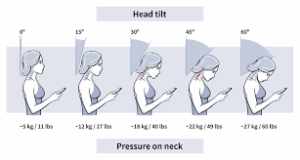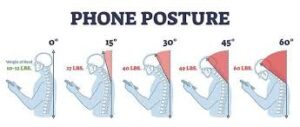

Ever find yourself stuck in a texting marathon so intense that when you finally glance up from your phone, your neck protests louder than your teenage self at curfew?
Congratulations!
You’ve officially experienced “text neck,” a uniquely modern ailment brought on by our relentless smartphone obsession.
But how exactly do these innocent-looking texting sessions morph into something capable of turning your neck muscles into knots tighter than your budget at the end of the month?
BestForwardHeadPostureFix research staff shall cover all these points in detail:
In This Article:
Introduction: The Silent Rebellion of Your Neck
- The humorously painful reality of “text neck”
- When your smartphone turns from companion to culprit
The Neck Muscles: Unsung Heroes or Unwilling Victims?
- Meet your hardworking neck muscles
- The surprising physics behind your texting posture (hint: it’s heavy!)
Timing Trouble: How Much Texting Is Too Much?
- When casual scrolling secretly becomes hazardous
- The tipping point between innocent texting and serious neck strain
Symptoms: Your Neck’s SOS Message
- Persistent neck pain—more than just an inconvenience
- Shoulder and upper-back discomfort: when your neck shares the misery
- Headaches: the painful bonus of constant texting
- Reduced mobility: the unexpected stiffness that sneaks up on you
Inside Your Neck’s Protest: What’s Really Happening?
- Why your muscles resent prolonged texting
- How sustained posture translates into muscle fatigue and painful knots
Most Affected Muscles: The Key Players in Text Neck
- Trapezius: the muscle that feels like you’ve carried invisible weights all day
- Levator Scapulae: why your shoulders always feel tense
- Sternocleidomastoid (SCM): the hidden reason you can’t turn your head smoothly
- Cervical Extensor Muscles: silently begging you to look up from your screen
- Scalene Muscles: the overlooked muscles that limit your neck’s flexibility
Factors Worsening Your Neck Pain (Beyond Just Duration)
- Why the angle of your head tilt matters
- Frequency of texting sessions: short and frequent can be deceptively harmful
- Fitness level and age: the hidden factors behind your neck’s endurance
Long-Term Impact: When Text Neck Sticks Around
- Muscle imbalances: the lasting legacy of poor posture
- Spinal misalignment: how your spine quietly shifts over time
- Accelerated wear-and-tear: the unseen effects of chronic text neck
- FAQs on Long Texting Sessions and Poor Neck Posture
Takeaway: Love Your Smartphone, Respect Your Neck
- Balancing connectivity with neck health
- A humorous but important reminder to listen to your body
The Curious Case of Your Neck Muscles
Our neck muscles are unsung heroes, quietly supporting an average head weight of about 10 to 12 pounds (imagine balancing a large bowling ball on a stick—that’s your neck’s daily grind).
According to experts at Spine Health, tilting your head forward at a mere 15-degree angle can double that weight to about 27 pounds.
Lean it further forward to 45 degrees—the typical texting posture—and it’s akin to balancing nearly 50 pounds on your delicate cervical spine.
Ouch, right?
Think about it like this: it is like carrying around a medium-sized Labrador Retriever on your neck every time you send a “quick” reply. Cute, but definitely painful after a while.
Ticking Timebomb: When Does Texting Get Risky?
Now, how long does it take for texting to go from a harmless distraction to full-blown muscle rebellion?
Kaiser Permanente health specialists caution that consistently engaging in texting for 15 to 20 minutes without taking breaks significantly escalates the risk of developing text neck symptoms.
Yes, that is roughly the duration of a good Instagram scroll or a Twitter debate that probably didn’t need your input.
Ironically, many smartphone users underestimate how long they actually spend glued to their screens.
A “quick message” frequently turns into an hour-long dive into digital conversations, memes, and video loops, all while your poor neck silently begs for mercy.
Symptoms: Your Neck’s Cry for Help
You might initially dismiss text neck symptoms as mere inconvenience or age catching up to you, but your body could be sending serious signals:
- Persistent Neck Pain: Spine Health highlights that this usually starts as a dull ache but can escalate quickly into sharper pains.
- Shoulder and Upper Back Soreness: As per Medical News Today, text neck doesn’t stop at your neck. It generously shares discomfort with your shoulders and upper back.
- Annoying Headaches: Yes, texting might literally become a headache. Muscle tension at the base of your skull frequently evolves into tension headaches.
- Reduced Mobility: If turning your head to check traffic becomes as stiff as your uncle at a dance party, you might be looking at reduced neck mobility from prolonged texting.
What’s Really Happening Inside? (Or, Why Your Neck is Revolting)
Ever wondered why your neck gets so cranky after binge-texting? Physiologically speaking, your neck muscles aren’t fans of prolonged static postures.
The constant forward tilt required to read or reply to texts forces your cervical extensors (the muscles responsible for holding your head upright) into continuous contraction.
Imagine holding a heavy grocery bag at arm’s length—easy initially, right?
But after a few minutes, your arm muscles start shaking and protesting loudly. That’s exactly what your neck muscles experience during extended texting sessions.
According to research published in Surgical Technology International, prolonged contraction leads to muscle fatigue, inflammation, and those nasty little trigger points—painful knots that turn massage therapists into superheroes.
FAQs on Long Texting Sessions and Poor Neck Posture
Q-1: Why Do Long Texting Sessions Strain Neck Muscles?
A-1: Texting usually pulls your chin down and your head forward. That small tilt ramps up the load your neck must support, because the farther the head moves in front of your shoulders, the harder your neck and upper-back muscles have to work. Typical texting angles sit around the 25–30° mark, which is enough to fatigue muscles, irritate joints and ligaments, and leave your traps tight by the end of a long chat.
Q-2: How Long Is “Too Long” Before My Neck Starts Complaining?
A-2: There is not a magic minute, but risk climbs with uninterrupted time. Many people notice stiffness after 20–30 minutes without a posture reset, and neck pain is more common in heavy, day-long screen users. Think “dose plus duration”: deeper angles and longer sessions add up. If you’re texting for hours, break the streak into short bouts and sprinkle in quick movement to keep tissues happy.
Q-3: What Symptoms Should I Watch For, And When Should I Worry?
A-3: The usual suspects are a dull ache at the base of the skull, tight shoulders, upper-back soreness, and tension headaches after long messaging runs. Short-lived soreness that eases with rest and gentle mobility is common. Red flags include tingling, numbness, or shooting pain into the arm or hand; persistent headaches; or weakness. If those show up—or pain hangs around despite self-care—check in with a clinician.
Q-4: Do Micro-Breaks Or Movement “Snacks” Actually Help?
A-4: Yes. Brief, frequent changes of position offload muscles before they fatigue. Try a 20–30-minute cadence: look up, draw your chin straight back, roll your shoulders, and gently nod the head through a small range. Even a 30–60-second reset reduces cumulative strain. Bonus points for alternating between sitting and standing, or switching hands to spread the workload.
Q-5: What Are The Easiest Technique Tweaks To Save My Neck While Texting?
A-5: Bring the phone up, not your head down. Rest elbows on armrests or a pillow, use two hands, and keep the screen closer to eye level. For longer replies, switch to voice-to-text. Keep messages in short bursts, then reset with neck stretches, shoulder blade squeezes, and gentle neck turns. And remember: typing tends to bend your neck more than passive scrolling—so pause more often when you are composing.
Which Muscles of the Neck are Affected the Most by Texting?
Here are the main muscles in your neck that are affected the most when you spend too much time texting messages on your cellphone:
Trapezius Muscle:
Often considered the ‘stress muscle,’ prolonged forward head posture during texting significantly strains the trapezius.
Persistent tension here can result in soreness, stiffness, and chronic discomfort across the neck and upper back, making you feel like you have been carrying bricks instead of a lightweight phone (Spine Health).
Levator Scapulae Muscle:
This muscle plays a key role in elevating and rotating your shoulder blades. When your head remains tilted forward excessively during texting, the levator scapulae endure continuous stress, leading to dull, nagging pain and limited neck movement.
It might even convince you your shoulders have decided to permanently reside near your ears (Medical News Today).
Sternocleidomastoid (SCM):
This long muscle running from the skull behind your ears down to your collarbone is crucial in turning and tilting your head.
Texting forces it into a stretched and strained position for long hours, causing painful spasms, stiffness, and reduced flexibility.
If you have ever felt unable to smoothly turn your head after a texting marathon, blame your overworked SCM (European Spine Journal).
Cervical Extensor Muscles:
Located at the back of your neck, these muscles support the weight of your head. Constantly bending your head forward to peer at your smartphone overloads these muscles, causing chronic fatigue, tenderness, and potential inflammation.
Your neck extensor muscles protesting is the body’s subtle way of asking, “Can we finally put the phone down?” (Surgical Technology International).
Levator Scapulae:
This muscle elevates your shoulder blade and helps maintain proper posture. Excessive texting forces unnatural positions, leading to painful stiffness and limited neck mobility.
Before you know it, turning your head to glance sideways feels like rotating a rusty hinge (European Spine Journal).
Factors Making Text Neck Worse (Spoiler: It’s Not Just Duration)
Several other factors beyond duration influence how severely texting affects your neck:
- The Tilt Angle: The steeper your head’s tilt, the heavier the burden on your neck. A slight tilt may feel inconsequential, but gravity vehemently disagrees.
- Frequency of Texting: Short sessions might seem harmless individually, but frequent bursts throughout the day accumulate significant strain, according to Spine Health experts.
- Personal Fitness Level: Let’s face it—not all necks are created equal. Individuals with stronger neck and upper back muscles tend to withstand longer texting sessions better, while those with weaker musculature might feel pain sooner.
- Age Factor: As per findings from the European Spine Journal, younger smartphone users (aged 18-24) frequently report higher incidences of neck pain related to texting habits. The irony? Youth, supposedly invincible, feeling the pinch (literally) of technology.
The Long-term Drama: Chronic Neck Strain and Beyond
Repeated bouts of text neck aren’t just short-term annoyances.
If you ignore these warning signs, chronic issues may develop, turning occasional discomfort into lifelong battles:
- Muscle Imbalances: Constant forward head posture weakens some muscles while overtaxing others, creating muscle imbalances that are harder to fix than a badly cooked meal.
- Spinal Misalignment: Prolonged poor posture can gradually alter your cervical spine’s natural curve, potentially leading to exaggerated spinal curvatures (think hunchback-like posture).
- Accelerated Degenerative Conditions: Long-term text neck may accelerate conditions like degenerative disc disease, as detailed by Spine Health, potentially resulting in chronic pain and mobility issues down the road.
Texting: The Modern-Day Nemesis (But You Still Love It)
So yes, your smartphone—your trusty companion—is secretly plotting a rebellion against your cervical spine.
But don’t panic yet.
Awareness is half the battle.
While this article would not delve into solutions (no spoilers here), understanding the mechanics behind your texting habits equips you to recognize when your neck’s patience has run thin.
After all, forewarned is forearmed—unless, of course, your arm hurts from holding your phone up too long. But that is another article.
References:

